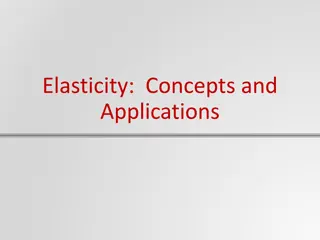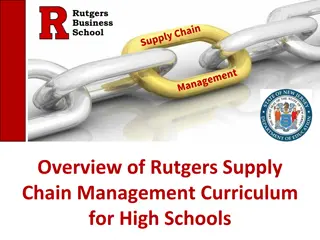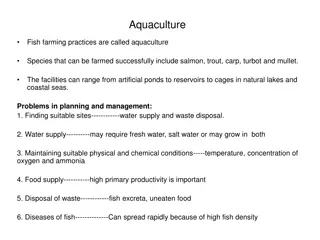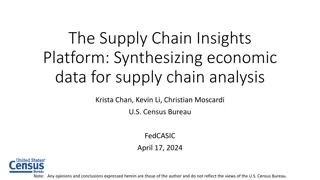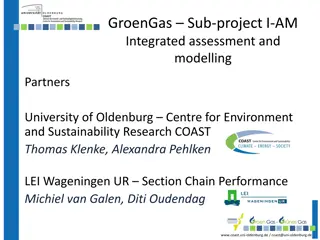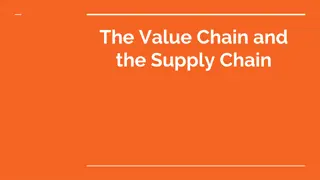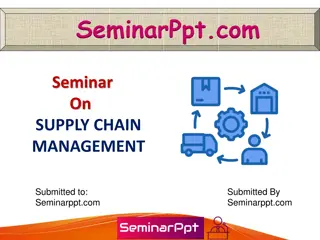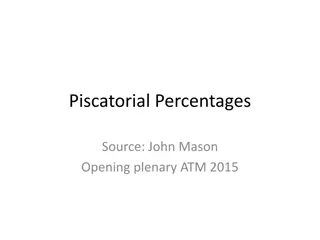Analysis of Price Links in the Fish Supply Chain
This research delves into methods for measuring price links within the fish supply chain, considering factors such as demand, marketing inputs, and price transmission. The study explores the elasticity of demand, substitution possibilities, and models to assess price and margin flexibilities in the industry. It also examines the stochastic behavior of fish prices, retail demand shifts, and marketing cost indices to understand the dynamics of pricing in the fish market.
Download Presentation

Please find below an Image/Link to download the presentation.
The content on the website is provided AS IS for your information and personal use only. It may not be sold, licensed, or shared on other websites without obtaining consent from the author.If you encounter any issues during the download, it is possible that the publisher has removed the file from their server.
You are allowed to download the files provided on this website for personal or commercial use, subject to the condition that they are used lawfully. All files are the property of their respective owners.
The content on the website is provided AS IS for your information and personal use only. It may not be sold, licensed, or shared on other websites without obtaining consent from the author.
E N D
Presentation Transcript
Methods on Measuring Prices Links in the Fish Supply Chain Daniel V. Gordon Department of Economics University of Calgary FAO Workshop Value Chain Tokyo, Japan December 2010
Introduction The demand for fish is derived by end-use demand for the commodity. The retail price will reflect the fish price plus the cost of marketing the commodity from the vessel to the retail level. Let the retail/vessel price margin be the difference between the retail and vessel price. The impact of a shock somewhere in the supply chain on price will depend on the structure of the relationship between the two sectors 2
Consider a fixed proportions relationship between fish supply and marketing inputs 3
Assume that proportionally larger amounts of marketing inputs are required to process increased supply of fish. 5
Supply of marketing inputs is perfectly elastic but substitution possibilities exist between the fish commodity and marketing inputs, the derived fish demand curve is more elastic Wohlgenant and Haidacher (1989) argue that processors can choose alternative production processes, including different modes of transporting, interproduct substitutability and the substitution of quality for quantity. 6
An interesting model by Wohlgenant (1989) and Holloway (1991). Provides summary measures of the price and margin flexibilities = + + + 1 + M MC RD L i m mmc i mrd i mq i = + + + 2 + pr MC RD L i pr prmc i prrd i prq i = + + + 1 + pf MC RD L i pf pf i pfrd i pfq i 8
Retail Demand Shift Variable and Marketing Cost Index Consider the following price transmission equation describing the stochastic behaviour of fish prices. 9
The Rd shift variable is defined as the linear combination: Why is it that we require premeasured elasticities? The problem is statistically consistency. 10
The Rd index is deterministic and it might be an advantage to introduce a stochastic error term to account for unobserved randomness 11
Estimated Elasticities Price of Sirloin/kg Price of chicken/kg Price of Non-Food Income Population Estimated Elasticity 0.25 0.15 0.09 0.81 1.0 12
Marketing Cost Index The Mc index is a weighted price index of the cost of inputs used in moving fish product through the supply chain. We have identified four major inputs in fish processing; labour, electricity, transportation and packaging. The weights in the index reflect the cost share of the input in the total cost of processing. 14
Cost Share Major Inputs Fish Processing Price of Labour Electricity 0.51 0.18 Price of Price of Transportation 0.16 Price of Packaging 0.15 Cost Share 15
Mc index is written Combining the real price indices with the cost shares we are able to predict the marketing cost index for seafood processing 16
Reduced Form Models This price approach is based on the theory of derived demand where the processed price of fish is used as a proxy for market factors setting the ex-vessel price. Univariate analysis is carried out on the ex- vessel price of fish. The ARMAX model is well identified and will allow for dynamic forecasts of ex-vessel prices. 18
Selecting the correct lag specification critical for generating an estimated equation with good forecasting potential. Review the autocorrelation and partial autocorrelation functions Candidate specifications defined on testing iid Box-Lung Q-statistic RMSE and AIC statistics. 19
ARMAX Model p q 12 Exvessel = + + 1 + 1 Exvessel + 1 + = = = Ex D t o p t s s Vi t i j t j t s i j Model with stationary variables 20
Error-Correction Modelling Recognizing the structural links between the first-hand and processing, we postulate a long-run price relationship. An error-correction (EC) model can be used to econometrically identify both the short- and long- run parameters for the first-hand market and predict the length of time for price adjustment to regain the long-run equilibrium 21
In a pairwise comparison of prices it is not unreasonable to think of an economic equilibrium describing the long-run relationship and written in basic form as 22
in a short run distributed lag representation the error-correction model can be written All arguments stationary The speed of adjustment to a short-run price shock can be approximated 23
Testing weak exogeneity Long-run exogeneity tested by including the error-correction term as an additional regressor. Short-run exogeneity tested by using fitted residuals from this equation and adding this as an additional variable error correction 24







